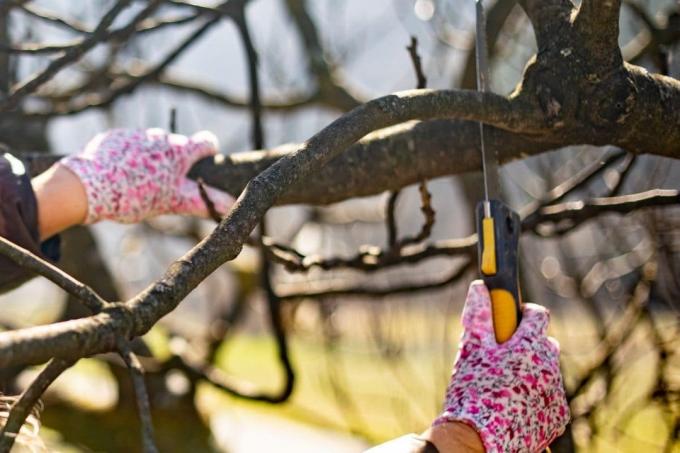
table of contents
- Basics
- Upbringing
- Taper cut
- Radical cut
- frequently asked Questions
A Fig tree (Ficus carica) can be kept small and "youthful" fresh with special cutting techniques. However, this requires the correct pruning instructions, which are discussed below.
In a nutshell
- right time for pruning is important
- Carry out education and rejuvenation cuts
- Radical pruning for very light, aged fig trees
Basics
In local regions, a fig can grow to well over five meters in height. For some hobby gardeners this is too high. Apart from that, the Mediterranean plant loses vitality with every meter of height and age. As a result, the Ficus carica can become lighter and lighter and the fruiting process can be reduced continuously. If you want to keep your fig tree small, you cannot avoid cutting either. It is important to use the right cutting technique at the right time.
Upbringing
With the upbringing pruning, you can keep a fig tree small from the start. This is especially for them Bucket cultivation of importance so that no giant plant develops that can no longer be moved to move to winter quarters.
Best time
Overwintered a fig tree in mild regions outdoors, the upbringing should be done in late winter between mid-February and mid-March.

Bucket specimens are cut when they are put outside from their winter quarters. It is advisable to wait for the acclimatization phase. These should be given fig trees to get used to the warmer sun. Otherwise there is a risk of burns. Because cutting always means stress for the plants, a time in the middle to the end of March is optimal. If the winter is mild and buckets get used to the fresh air early on, cutting can be done from mid-February.
Ideally, the training pruning should start with the young plants.
instructions
- immediately after planting: remove all bottom shoots except for the central shoot at the roots
- Cut regularly except for four side shoots (basic structure) on the central shoot
- Guide the center drive straight up through the support bracket; here the trunk lengthened to the crown
- To form the crown, do not cut the central shoot until at least four buds are visible above the desired crown attachment
- then cut off the tip at least an inch above the buds
- Cut the trees in a pyramid shape from bottom to top
- Frequency: once a year depending on the rate of growth and the desired height; slight correction cuts possible from the end of July to the middle of August
Note: Shorten the tip of the central shoot before four or six buds have formed, “train” yourself a measly growth and keep the fig tree so small.
Taper cut
A rejuvenation cut stimulates old wood shoots to form new ones. This leads to a revitalization of older fig trees in particular and ensures dense foliage and high fruit yields.
Best time

For the rejuvenation cut, you should choose an appointment before the leaves appear for the first time. This is usually the case until the late winter months of February and March. If the bud is already in full swing, too much energy is put into this process. As a result, there is a lack of energy and strength to grow fresh new shoots from the "sleeping eyes" and make fig trees appear young.
Taper cut
- Cut off frozen and frozen branches
- Remove dead old wood at the base
- Divert remaining branches to deep and outward side shoots
- "loosen" intersecting and closely spaced branches by means of a section
- Frequency of cuts: annually; Exception: cutting of ground shoots only required every five to ten years
Tip: A look at the tissue helps to clearly identify dead branches. To do this, the branch is slightly scratched. If there is a dry, brownish tissue under the bark, it is a dead branch.
Radical cut
If a fig tree has not been pruned for many years and it is very sparse with stunted growth fruit, a taper cut is often no longer sufficient. Then a radical pruning can help the decrepit Ficus carica to regain its youthfulness. However, this also means that fruiting will not develop at least for the cutting year.
instructions
- Choose a frost-free winter day between the end of February and the beginning of April during the leaf-free period
- Shorten the tree to 30 centimeters
- do not make any further cuts in the year
- Cut off half of the strongest shoots in the following year
- Remove the remaining side shoots at the base and make a training cut
- Frequency: as rarely as possible and never for two years in a row

Note: When pruning and especially with radical pruning, plenty of milky sap can escape from fig trees. Skin contact can cause itching and allergies with rashes and eczema, which is why you should always wear gloves and long clothing when cutting.
frequently asked Questions
In order to revitalize extensively frozen / frozen-back fig trees, only a radical cut usually helps. How you should proceed is described in the guide with appropriate instructions. In most cases, the affected plants recover and sprout again in the same year.
For a fig tree, pruning always means an intervention in natural processes and a high level of stress. This is particularly the case in autumn because the Ficus carica is then already preparing for winter and the urgently needed hibernation. Cutting back would demand a lot from the tree and, in the worst case, weaken it too much for the winter season.
The main branches form the basic structure. The branches, which ensure the dense growth and ultimately the height and width of growth, branch off from them. Regular pruning of the leading branches and the removal of old branching branches allow new shoots to grow for a young look.
